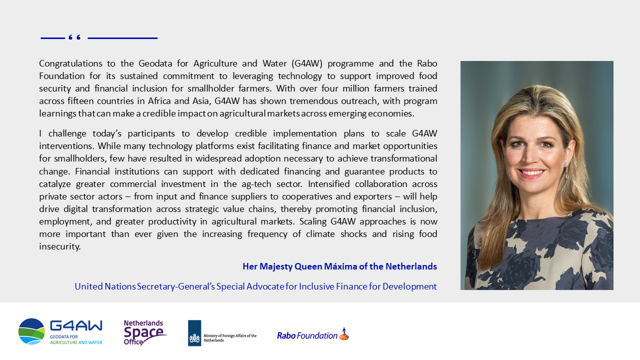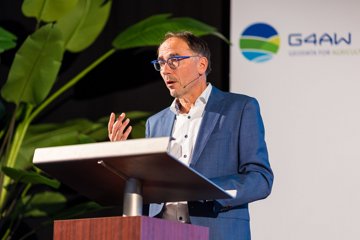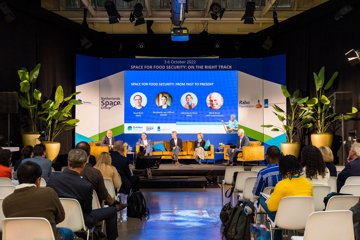Queen Máxima: 'Scaling G4AW approaches more important than ever'
Four million farmers in developing countries discovered the added value of satellite data thanks to G4AW, a programme run by NSO on behalf of the Ministry of Foreign Affairs. Last week, the balance sheet was taken at the G4AW Conference in Utrecht. Queen Máxima summarised the results in a personal written message and congratulated all parties involved: 'G4AW provided insights that can make a valuable contribution to agriculture in emerging economies.'
G4AW - Geodata for Agriculture and Water - deals with very concrete questions from farmers in developing countries: what is the best time to sow? Due to the expected rain, is it better to fertilise my land today or tomorrow? How do I secure my harvest? Questions that can be answered using satellite information and other digital applications, says Ruud Grim of the NSO: 'Access to the right information can make the difference between food security or hunger, between a thriving local economy or poverty. So we need to work together to ensure that the right information reaches the right people at the right time.'

Gap closed
Parties that often worked alongside each other in the past have been brought together by the G4AW programme: development cooperation, international policy organisations, scientists, agricultural organisations and service providers from the space, agriculture, ICT, lenders and impact investors sectors. This is the strength of the programme, Grim believes: 'We have shown that we can bridge the gap between high-tech digital applications and individual users in developing countries. This offers great opportunities for food production, but also for water management, poverty alleviation and other global, societal issues, for example.'

Ruud Grim of NSO: 'We have shown that we can bridge the gap.'
Together with other initiatives, G4AW put digitalisation in development cooperation on the map with 25 public-private partnerships in 15 different countries. 'You can see the success of collaboration,' says independent strategic advisor and moderator of the conference Raimond Hafkenscheid. 'You cannot expect a sensor developer in the field of geodata to know how satellite data can affect a farmer's income in Uganda. You need other parties and service providers for that. And an intermediary, like NSO, that brings them together.'
Scaling up is important
In collaboration with Rabo Foundation, the conference had a special focus on inclusive finance. For small-scale farmers, it is difficult to get small financing for operations. This is because the returns on small loans for financial institutions do not outweigh the operational costs they have to incur to do so. Here too, satellite data and digitalisation can play an important role, Hafkenscheid concludes: 'Through G4AW, financial institutions have discovered that you can estimate what the harvest will be, what the damage will be in case of drought and what the risk of a crop failure is. And therefore also what the risk is of a loan not being repaid. If you use this data, in combination with insurance and advisory services for the farmers, you bring the operational costs down so much that it does become interesting for financial institutions to invest in the agricultural sector in developing countries'.
 Queen Máxima, who is committed to microfinance, praised the steps G4AW has taken together with the Rabo Foundation to enable inclusive financing. 'Increased collaboration with the private sector encourages digital transformation of strategic value chains. It promotes financial inclusion, employment and greater agricultural productivity. Scaling up G4AW approaches is more important than ever, given the increasing frequency of climate shocks and rising food insecurity.'
Queen Máxima, who is committed to microfinance, praised the steps G4AW has taken together with the Rabo Foundation to enable inclusive financing. 'Increased collaboration with the private sector encourages digital transformation of strategic value chains. It promotes financial inclusion, employment and greater agricultural productivity. Scaling up G4AW approaches is more important than ever, given the increasing frequency of climate shocks and rising food insecurity.'
End-user central
Now it is a matter of pressing on, agrees Hafkenscheid: 'This conference shows how much ground has been gained with G4AW, but also how complicated the challenge that still lies ahead is. The key here is the end user. We must continue to take them as a starting point for future developments. Not: what can we make? And then wait and see whether it works. But: what do you need? How do you want to receive that information? And from which provider? This creates high-tech solutions that offer real added value to farmers and other entrepreneurs in developing countries'.